Mediation of Sinusoidal Network Oscillations in the Locus Coeruleus of Newborn Rat Slices by Pharmacologically Distinct AMPA and KA Receptors
Abstract
:1. Introduction
2. Materials and Methods
2.1. Preparation and Solutions
2.2. Agents and Drug Application
2.3. Electrophysiological Recording
2.4. Data Analysis
3. Results
3.1. AMPA-Evoked LFP Oscillations
3.2. KA-Evoked LFP Oscillations
3.3. Combined LFP and Vm Analysis of AMPAR Agonist Effects
3.4. Effects of Increased Network Excitability via Raised Extracellular K+
3.5. Effects of Specific Blockers of Anion Channel-Mediated Inhibition
3.6. Effects of iGluR Blockers on LFP Oscillations
4. Discussion
4.1. Complex-Mediated Spindle-Shaped Faster and More Regular Network Rhythm
4.2. Consequences for Modeling of Neonatal LC Network Properties and Function
4.3. Potential Role of AMPAR and KAR in Neonatal LC
Author Contributions
Funding
Institutional Review Board Statement
Informed Consent Statement
Data Availability Statement
Conflicts of Interest
References
- Rawal, B.; Rancic, V.; Ballanyi, K. NMDA enhances and glutamate attenuates synchrony of spontaneous phase-locked locus coeruleus network rhythm in newborn rat brain slices. Brain Sci. 2022, 12, 651. [Google Scholar] [CrossRef]
- Foote, S.L.; Bloom, F.E.; Aston-Jones, G. Nucleus locus ceruleus: New evidence of anatomical and physiological specificity. Physiol. Rev. 1983, 63, 844–914. [Google Scholar] [CrossRef] [PubMed]
- Berridge, C.W.; Waterhouse, B.D. The locus coeruleus-noradrenergic system: Modulation of behavioral state and state-dependent cognitive processes. Brain Res. Rev. 2003, 42, 33–84. [Google Scholar] [CrossRef]
- Poe, G.R.; Foote, S.; Eschenko, O.; Johansen, J.P.; Bouret, S.; Aston-Jones, G.; Harley, C.W.; Manahan-Vaughan, D.; Weinshenker, D.; Valentino, R.; et al. Locus coeruleus: A new look at the blue spot. Nat. Rev. Neurosci. 2020, 21, 644–659. [Google Scholar] [CrossRef] [PubMed]
- Herkenham, M.; Nauta, W.J. Efferent connections of the habenular nuclei in the rat. J. Comp. Neurol. 1979, 187, 19–47. [Google Scholar] [CrossRef] [PubMed]
- Aston-Jones, G.; Ennis, M.; Pieribone, V.A.; Nickell, W.T.; Shipley, M.T. The brain nucleus locus coeruleus: Restricted afferent control of a broad efferent network. Science 1986, 234, 734–737. [Google Scholar] [CrossRef] [PubMed]
- Aston-Jones, G.; Shipley, M.T.; Chouvet, G.; Ennis, M.; van Bockstaele, E.; Pieribone, V.; Shiekhattar, R.; Akaoka, H.; Drolet, G.; Astier, B.; et al. Afferent regulation of locus coeruleus neurons: Anatomy, physiology and pharmacology. Prog. Brain Res. 1991, 88, 47–75. [Google Scholar] [PubMed]
- Luppi, P.H.; Aston-Jones, G.; Akaoka, H.; Chouvet, G.; Jouvet, M. Afferent projections to the rat locus coeruleus demonstrated by retrograde and anterograde tracing with cholera-toxin B subunit and Phaseolus vulgaris leucoagglutinin. Neuroscience 1995, 65, 119–160. [Google Scholar] [CrossRef]
- Jodo, E.; Aston-Jones, G. Activation of locus coeruleus by prefrontal cortex is mediated by excitatory amino acid inputs. Brain Res. 1997, 768, 327–332. [Google Scholar] [CrossRef]
- Singewald, N.; Philippu, A. Release of neurotransmitters in the locus coeruleus. Prog. Neurobiol. 1998, 56, 237–267. [Google Scholar] [CrossRef]
- Schwarz, L.A.; Miyamichi, K.; Gao, X.J.; Beier, K.T.; Weissbourd, B.; DeLoach, K.E.; Ren, J.; Ibanes, S.; Malenka, R.C.; Kremer, E.J.; et al. Viral-genetic tracing of the input-output organization of a central noradrenaline circuit. Nature 2015, 7563, 88–92. [Google Scholar] [CrossRef] [Green Version]
- Totah, N.K.; Neves, R.M.; Panzeri, S.; Logothetis, N.K.; Eschenko, O. The locus coeruleus is a complex and differentiated neuromodulatory system. Neuron 2018, 99, 1055–1068. [Google Scholar] [CrossRef] [Green Version]
- Totah, N.K.B.; Logothetis, N.K.; Eschenko, O. Noradrenergic ensemble-based modulation of cognition over multiple timescales. Brain Res. 2019, 1709, 50–66. [Google Scholar] [CrossRef]
- Breton-Provencher, V.; Sur, M. Active control of arousal by a locus coeruleus GABAergic circuit. Nat. Neurosci. 2019, 22, 218–228. [Google Scholar] [CrossRef]
- Hansen, K.B.; Wollmuth, L.P.; Bowie, D.; Furukawa, H.; Menniti, F.S.; Sobolevsky, A.I.; Swanson, G.T.; Swanger, S.A.; Greger, I.H.; Nakagawa, T.; et al. Structure, Function, and Pharmacology of Glutamate Receptor Ion Channels. Pharmacol. Rev. 2021, 73, 298–487. [Google Scholar] [CrossRef]
- Price, R.B.; Nock, M.K.; Charney, D.S.; Mathew, S.J. Effects of intravenous ketamine on explicit and implicit measures of suicidality in treatment-resistant depression. Biol. Psychiatry 2009, 66, 522–526. [Google Scholar] [CrossRef] [Green Version]
- DiazGranados, N.; Ibrahim, L.A.; Brutsche, N.E.; Ameli, R.; Henter, I.D.; Luckenbaugh, D.A.; Machado-Vieira, R.; Zarate, C.A., Jr. Rapid resolution of suicidal ideation after a single infusion of an N-methyl-D-aspartate antagonist in patients with treatment-resistant major depressive disorder. J. Clin. Psychiatry 2010, 71, 1605–1611. [Google Scholar] [CrossRef] [Green Version]
- Chandley, M.J.; Ordway, G.A. Noradrenergic Dysfunction in Depression and Suicide. In The Neurobiological Basis of Suicide; Dwivedi, Y., Ed.; CRC Press: Boca Raton, FL, USA; Taylor & Francis: New York, NY, USA, 2012; Chapter 3. [Google Scholar]
- Zhu, H.; Zhou, W. Excitatory amino acid receptors are involved in morphine-induced synchronous oscillatory discharges in the locus coeruleus of rats. Eur. J. Pharmacol. 2005, 528, 73–78. [Google Scholar] [CrossRef] [PubMed]
- Akaoke, H.; Aston-Jones, G. Opiate withdrawal-induced hyperactivity of locus coeruleus neurons is substantially mediated by augmented excitatory amino acid input. J. Neurosci. 1991, 11, 3830–3839. [Google Scholar] [CrossRef] [Green Version]
- Williams, J.T.; Marshall, K.C. Membrane properties and adrenergic responses in locus coeruleus neurons of young rats. J. Neurosci. 1987, 7, 3687–3694. [Google Scholar] [CrossRef] [Green Version]
- Christie, M.J.; Williams, J.T.; North, R.A. Electrical coupling synchronizes subthreshold activity in locus coeruleus neurons in vitro from neonatal rats. J. Neurosci. 1989, 9, 3584–3589. [Google Scholar] [CrossRef] [PubMed] [Green Version]
- Christie, M.J. Generators of synchronous activity of the locus coeruleus during development. Semin. Cell Dev. Biol. 1997, 8, 29–34. [Google Scholar] [CrossRef] [PubMed]
- Marshall, K.C.; Christie, M.J.; Finlayson, P.G.; Williams, J.T. Developmental aspects of the locus coeruleus-noradrenaline system. Prog. Brain Res. 1991, 88, 173–185. [Google Scholar]
- Alvarez, V.A.; Chow, C.C.; Van Bockstaele, E.J.; Williams, J.T. Frequency-dependent synchrony in locus ceruleus: Role of electrotonic coupling. Proc. Natl. Acad. Sci. USA 2002, 99, 4032–4036. [Google Scholar] [CrossRef] [Green Version]
- Schwarz, L.A.; Luo, L. Organization of the locus coeruleus-norepinephrine system. Curr. Biol. 2015, 25, R1051–R1056. [Google Scholar] [CrossRef] [PubMed] [Green Version]
- Rawal, B.; Rancic, V.; Ballanyi, K. TARP mediation of accelerated and more regular locus coeruleus network bursting in neonatal rat brain slices. Neuropharmacology 2019, 148, 169–177. [Google Scholar] [CrossRef]
- Greger, I.H.; Watson, J.F.; Cull-Candy, S.G. Structural and functional architecture of AMPA-type glutamate receptors and their auxiliary proteins. Neuron 2017, 94, 713–730. [Google Scholar] [CrossRef]
- Maher, M.P.; Matta, J.A.; Gu, S.; Seierstad, M.; Bredt, D.S. Getting a handle on neuropharmacology by targeting receptor-associated proteins. Neuron 2017, 96, 989–1001. [Google Scholar] [CrossRef] [Green Version]
- Rancic, V.; Rawal, B.; Panaitescu, B.; Ruangkittisakul, A.; Ballanyi, K. Suction electrode recording in locus coeruleus of newborn rat brain slices reveals network bursting comprising summated non-synchronous spiking. Neurosci. Lett. 2018, 671, 103–107. [Google Scholar] [CrossRef]
- Waselenchuk, Q.; Ballanyi, K. Autocrine neuromodulation and network activity patterns in the locus coeruleus of newborn rat slices. Brain Sci. 2022, 12, 437. [Google Scholar] [CrossRef] [PubMed]
- Kantor, C.; Panaitescu, B.; Kuribayashi, J.; Ruangkittisakul, A.; Jovanovic, I.; Leung, V.; Lee, T.F.; MacTavish, D.; Jhamandas, J.H.; Cheung, P.Y.; et al. Spontaneous neural network oscillations in hippocampus, cortex, and locus coeruleus of newborn rat and piglet brain slices. In Isolated Central Nervous System Circuits; Neuromethods, Ballanyi, K., Eds.; Humana Press: Totowa, NJ, USA, 2012; Volume 73, pp. 315–356. ISBN 978-1-62703-019-9. [Google Scholar]
- Ishimatsu, M.; Williams, J.T. Synchronous activity in locus coeruleus results from dendritic interactions in pericoerulear regions. J. Neurosci. 1996, 16, 5196–5204. [Google Scholar] [CrossRef]
- Fisahn, A.; Contractor, A.; Traub, R.D.; Buhl, E.H.; Heinemann, S.H.; McBain, C.J. Distinct roles for the kainate receptor subunits GluR5 and GluR6 in kainate-induced hippocampal gamma oscillations. J. Neurosci. 2004, 24, 9658–9668. [Google Scholar] [CrossRef] [PubMed]
- Bartos, M.; Vida, I.; Jonas, P. Synaptic mechanisms of synchronized gamma oscillations in inhibitory interneuron networks. Nat. Rev. Neurosci. 2007, 8, 45–56. [Google Scholar] [CrossRef] [PubMed]
- Pietersen, A.N.J.; Patel, N.; Jefferys, J.G.R.; Vreugdenhil, M. Comparison between spontaneous and kainate-induced gamma oscillations in the mouse hippocampus In Vitro. Eur. J. Neurosci. 2009, 29, 2145–2156. [Google Scholar] [CrossRef]
- Schulz, S.B.; Klaft, Z.J.; Roesler, A.R.; Heinemann, U.; Gerevich, Z. Purinergic P2X, P2Y and adenosine receptors differentially modulate hippocampal gamma oscillations. Neuropharmacology 2012, 62, 914–924. [Google Scholar] [CrossRef]
- Johnson, N.W.; Ozkan, M.; Burgess, A.P.; Prokic, E.J.; Wafford, K.A.; O’Neill, M.J.; Greenhill, S.D.; Stanford, I.M.; Woodhall, G.L. Phase-amplitude coupled persistent theta and gamma oscillations in rat primary motor cortex In Vitro. Neuropharmacology 2017, 119, 141–156. [Google Scholar] [CrossRef]
- Ballanyi, K.; Ruangkittisakul, A. Structure-function analysis of rhythmogenic inspiratory pre-Bötzinger complex networks in “calibrated” newborn rat brainstem slices. Respir. Physiol. Neurobiol. 2009, 168, 158–178. [Google Scholar] [CrossRef] [PubMed]
- Pearlstein, E.; Ben Mabrouk, F.; Pflieger, J.F.; Vinay, L. Serotonin refines the locomotor-related alternations in the in vitro neonatal rat spinal cord. Eur. J. Neurosci. 2005, 21, 1338–1346. [Google Scholar] [CrossRef]
- Taccola, G.; Olivieri, D.; D’Angelo, G.; Blackburn, P.; Secchia, L.; Ballanyi, K. A1 adenosine receptor modulation of chemically and electrically evoked lumbar locomotor network activity in isolated newborn rat spinal cords. Neuroscience 2012, 222, 191–204. [Google Scholar] [CrossRef]
- Fietkiewicz, C.; Loparo, K.A.; Wilson, C.G. Drive latencies in hypoglossal motoneurons indicate developmental change in the brainstem respiratory network. J. Neural. Eng. 2011, 8, 065011. [Google Scholar] [CrossRef]
- Zanella, S.; Doi, A.; Garcia, A.J., III; Elsen, F.; Kirsch, S.; Wei, A.D.; Ramirez, J.M. When norepinephrine becomes a driver of breathing irregularities: How intermittent hypoxia fundamentally alters the modulatory response of the respiratory network. J. Neurosci. 2014, 34, 36–50. [Google Scholar] [CrossRef] [Green Version]
- Garcia, A.J., 3rd; Dashevskiy, T.; Khuu, M.A.; Ramirez, J.M. Chronic intermittent hypoxia differentially impacts different states of inspiratory activity at the level of the preBötzinger Complex. Front. Physiol. 2017, 8, 571. [Google Scholar] [CrossRef] [Green Version]
- Traynelis, S.F.; Dingledine, R. Potassium-induced spontaneous electrographic seizures in the rat hippocampal slice. J. Neurophysiol. 1988, 59, 259–276. [Google Scholar] [CrossRef]
- Smirnov, S.; Paalasmaa, P.; Uusisaari, M.; Voipio, J.; Kaila, K. Pharmacological isolation of the synaptic and nonsynaptic components of the GABA-mediated biphasic response in rat CA1 hippocampal pyramidal cells. J. Neurosci. 1999, 19, 9252–9260. [Google Scholar] [CrossRef] [PubMed]
- LeBeau, F.E.N.; Stephen, K.; Towers, S.K.; Roger, D.; Traub, R.D.; Whittington, M.A.; Eberhard, H.; Buhl, E.H. Fast network oscillations induced by potassium transients in the rat hippocampus In Vitro. J. Physiol. 2002, 542, 167–179. [Google Scholar] [CrossRef] [PubMed]
- Devor, A.; Yarom, Y. Electrotonic Coupling in the Inferior olivary nucleus revealed by simultaneous double patch recordings. J. Neurophysiol. 2002, 87, 3048–3058. [Google Scholar] [CrossRef] [PubMed]
- González-Montoro, A.M.; Cao, R.; Espinosa, N.; Cudeiro, J.; Mariño, J. Functional two-way analysis of variance and bootstrap methods for neural synchrony analysis. BMC Neurosci. 2014, 15, e96. [Google Scholar] [CrossRef] [Green Version]
- Gonzalez, O.J.A.; van Aerde, K.I.; van Elburg, R.A.J.; Poil, S.-S.; Mansvelder, H.D.; Linkenkaer-Hansen, K.; van Pelt, J.; van Ooyen, A. External Drive to Inhibitory Cells Induces Alternating Episodes of High- and Low-Amplitude Oscillations. PLoS Comp. Biol. 2012, 8, e1002666. [Google Scholar] [CrossRef] [Green Version]
- Tsintsadze, V.; Minlebaev, M.; Suchkov, D.; Cunningham, M.; Khazipov, R. Ontogeny of Kainate-Induced Gamma Oscillations in the Rat CA3 Hippocampus In Vitro. Front. Cell. Neurosci. 2015, 9, 195. [Google Scholar] [CrossRef] [Green Version]
- Avramiea, A.-E.; Masood, A.; Mansvelder, H.D.; Linkenkaer-Hansen, K. Long-range amplitude coupling is optimized for brain networks that function at criticality. J. Neurosci. 2022, 42, 2221–2233. [Google Scholar] [CrossRef]
- Olpe, H.R.; Steinmann, M.; Brugger, F.; Pozza, M. Excitatory amino acid receptors in rat locus coeruleus. Naunyn Schmiedebergs Arch. Pharmacol. 1989, 339, 312–314. [Google Scholar] [CrossRef] [PubMed]
- Zamalloa, T.; Bailey, C.P.; Pineda, J. Glutamate-induced post-activation inhibition of locus coeruleus neurons is mediated by AMPA/kainate receptors and sodium-dependent potassium currents. Br. J. Pharmacol. 2009, 156, 649–661. [Google Scholar] [CrossRef] [Green Version]
- Kogan, J.H.; Aghajanian, G.K. Long-term glutamate desensitization in locus coeruleus neurons and its role in opiate withdrawal. Brain Res. 1995, 689, 111–121. [Google Scholar] [CrossRef]
- Andrade, R.; Aghajanian, G.K. Locus coeruleus activity in vitro: Intrinsic regulation by a calcium-dependent potassium conductance but not alpha 2-adrenoceptors. J. Neurosci. 1984, 4, 161–170. [Google Scholar] [CrossRef] [PubMed] [Green Version]
- Jefferys, J.G. Experimental neurobiology of epilepsies. Curr. Opin. Neurol. 1994, 7, 113–122. [Google Scholar] [CrossRef] [PubMed]
- Ruangkittisakul, A.; Sharopov, S.; Kantor, C.; Kuribayashi, J.; Mildenberger, E.; Luhmann, H.J.; Kilb, W.; Ballanyi, K. Methylxanthine-evoked perturbation of spontaneous and evoked activities in isolated newborn rat hippocampal networks. Neuroscience 2015, 301, 106–120. [Google Scholar] [CrossRef] [PubMed]
- Lüthi, A. Sleep spindles: Where they come from, what they do. Neuroscientist 2014, 20, 243–256. [Google Scholar] [CrossRef]
- Sullivan, D.; Mizuseki, K.; Sorgi, A.; Buzsaki, G. Comparison of sleep spindles and theta oscillations in the hippocampus. J. Neurosci. 2014, 34, 662–674. [Google Scholar] [CrossRef] [Green Version]
- Jin, X.; Li, S.; Bondy, B.; Zhong, W.; Oginsky, M.F.; Wu, Y.; Johnson, C.M.; Zhang, S.; Cui, N.; Jiang, C. Identification of a group of GABAergic neurons in the dorsomedial area of the locus coeruleus. PLoS ONE 2016, 11, e0146470. [Google Scholar] [CrossRef]
- Li, Y.; Hickey, L.; Perrins, R.; Werlen, E.; Patel, A.A.; Hirschberg, S.; Jones, M.W.; Salinas, S.; Kremer, E.J.; Pickering, A.E. Retrograde optogenetic characterization of the pontospinal module of the locus coeruleus with a canine adenoviral vector. Brain Res. 2016, 1641, 274–290. [Google Scholar] [CrossRef] [Green Version]
- Latorre, R.; Aguirre, C.; Rabinovich, M.; Varona, P. Transient Dynamics and Rhythm Coordination of Inferior Olive Spatio-Temporal Patterns. Front. Neural Circ. 2013, 7, 138. [Google Scholar] [CrossRef] [PubMed] [Green Version]
- Ballanyi, K.; Eschenko, O. Anesthesia-related LC neuron bursting in adult rats in vivo. Manuscript in preparation.
- Kaeidi, A.; Azizi, H.; Javan, M.; Soleimani, S.M.A.; Fathollahi, Y.; Semnanian, S. Direct facilitatory role of paragigantocellularis neurons in opiate withdrawal-induced hyperactivity of rat locus coeruleus neurons: An in vitro study. PLoS ONE 2015, 10, e0134873. [Google Scholar] [CrossRef] [PubMed] [Green Version]
- Brofiga, M.; Pisano, M.; Raiteri, R.; Massobrio, P. On the road to the brain-on-a-chip: A review on strategies, methods, and applications. J. Neural Eng. 2021, 18, 041005. [Google Scholar] [CrossRef] [PubMed]
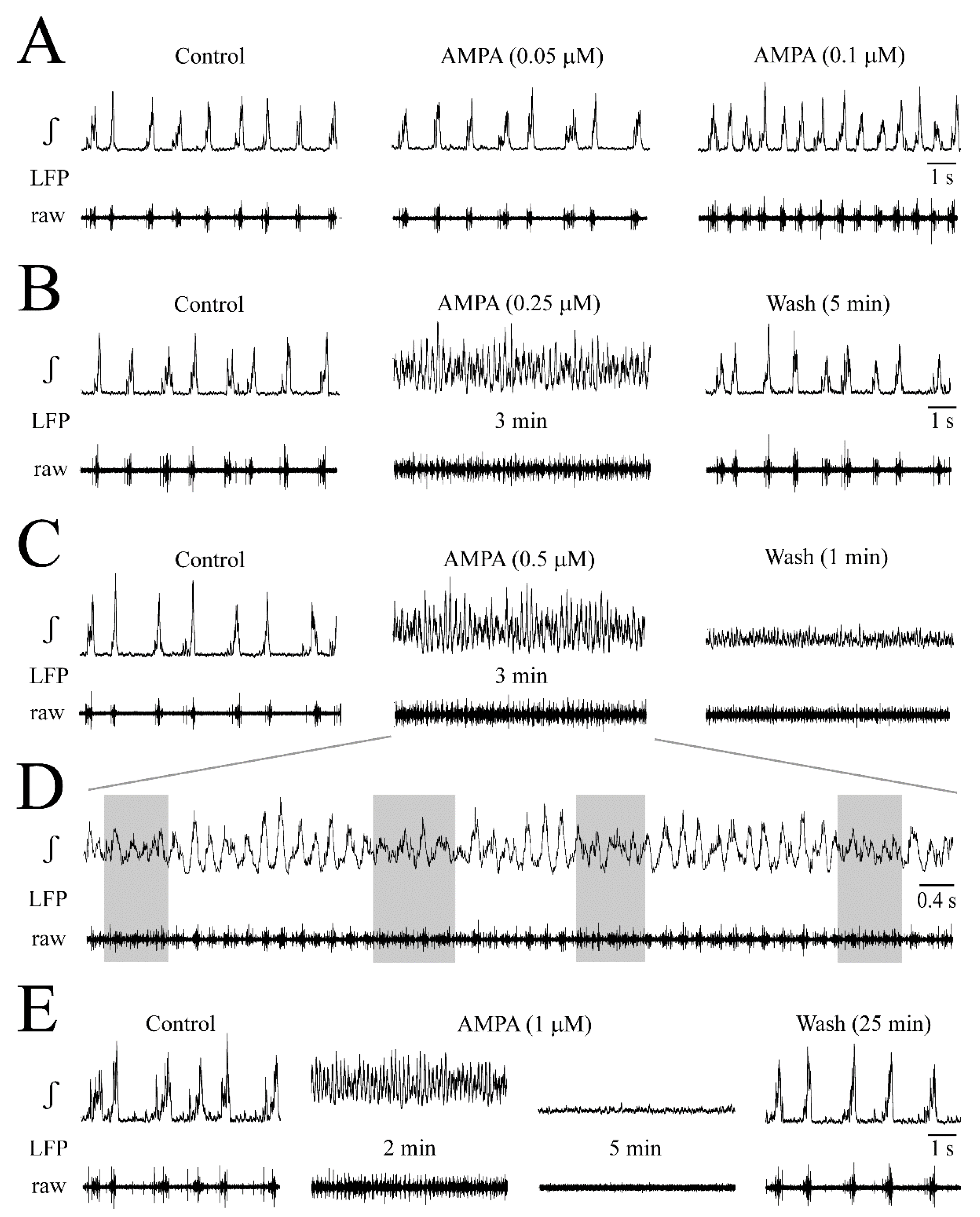
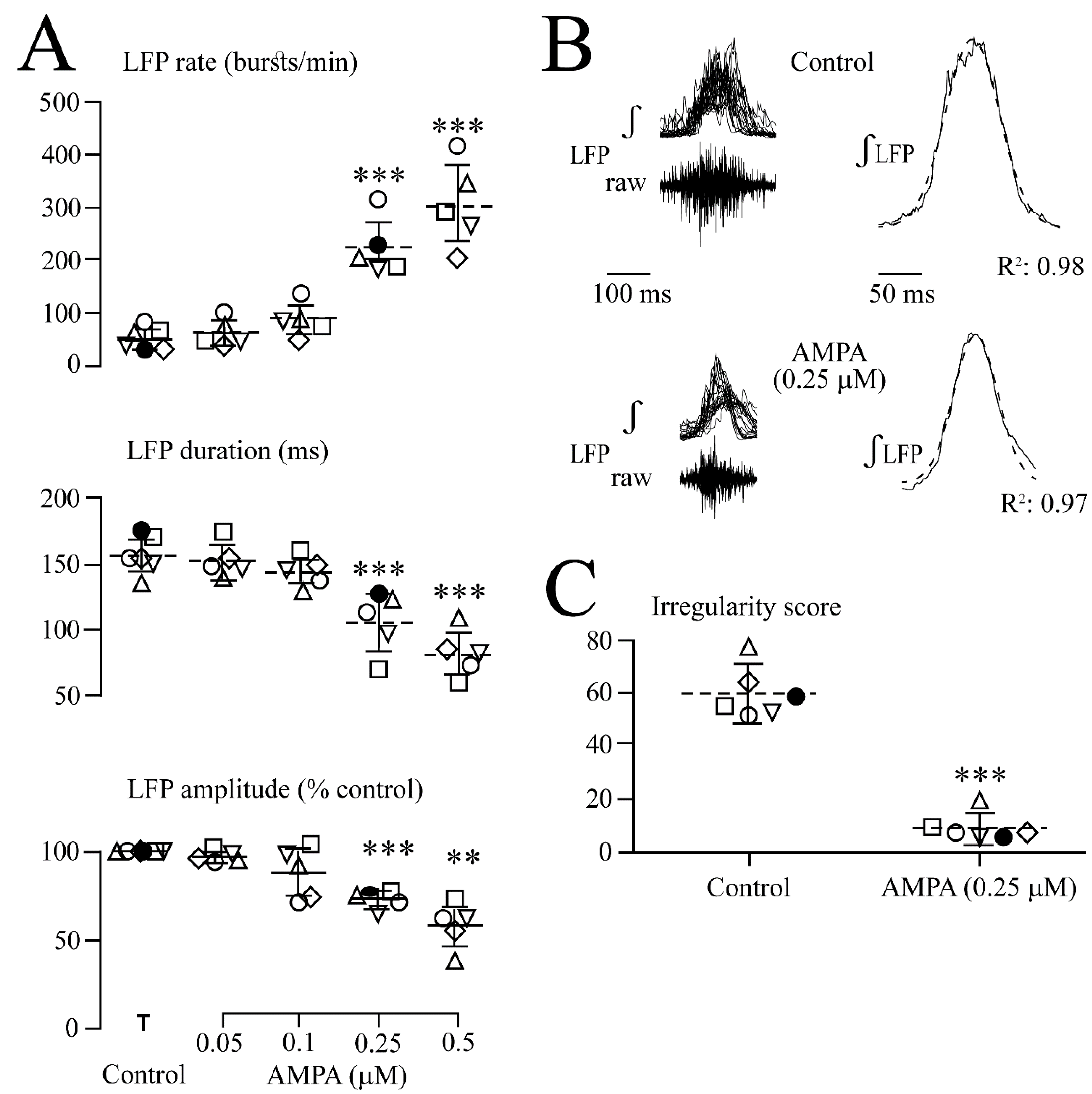
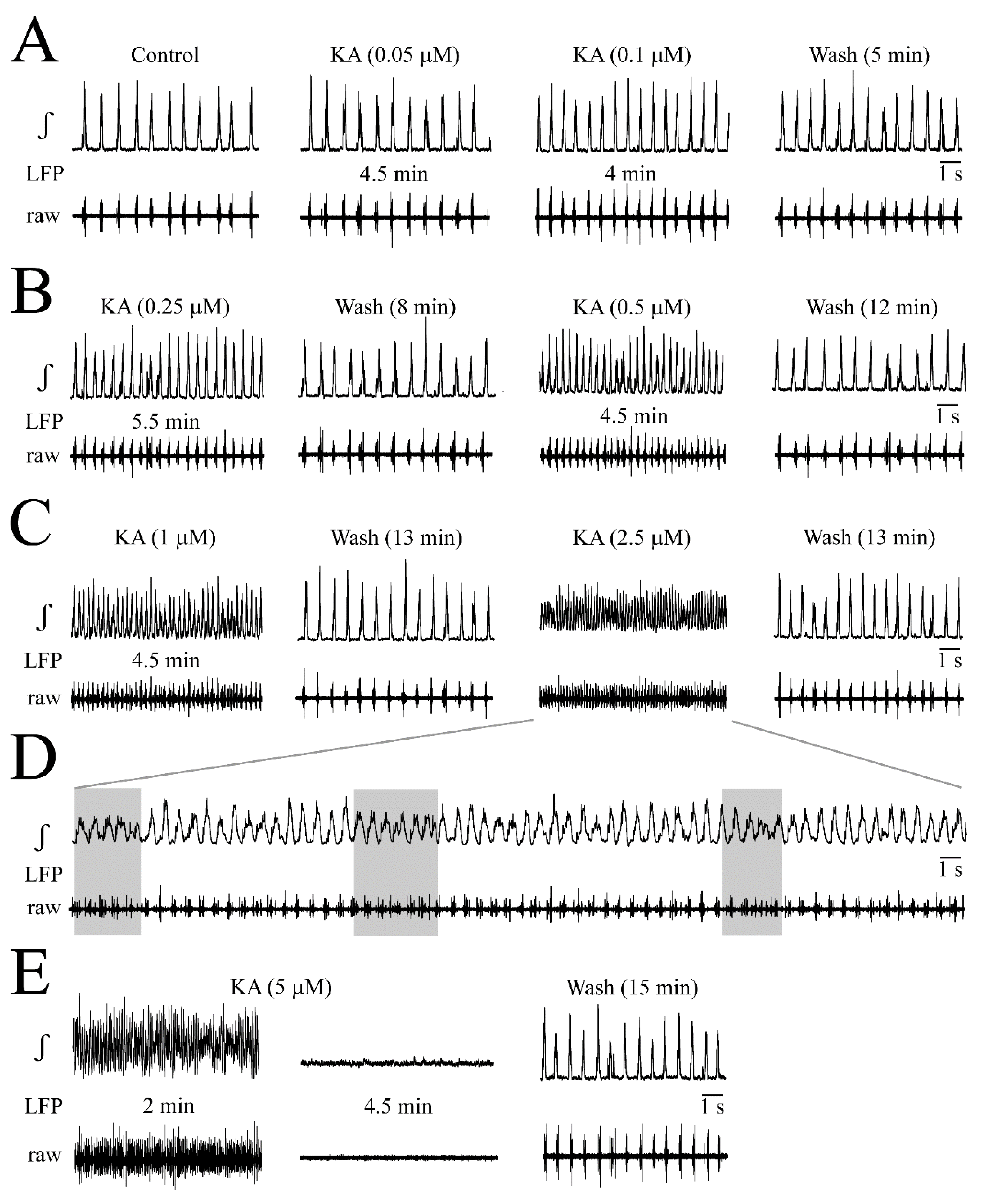
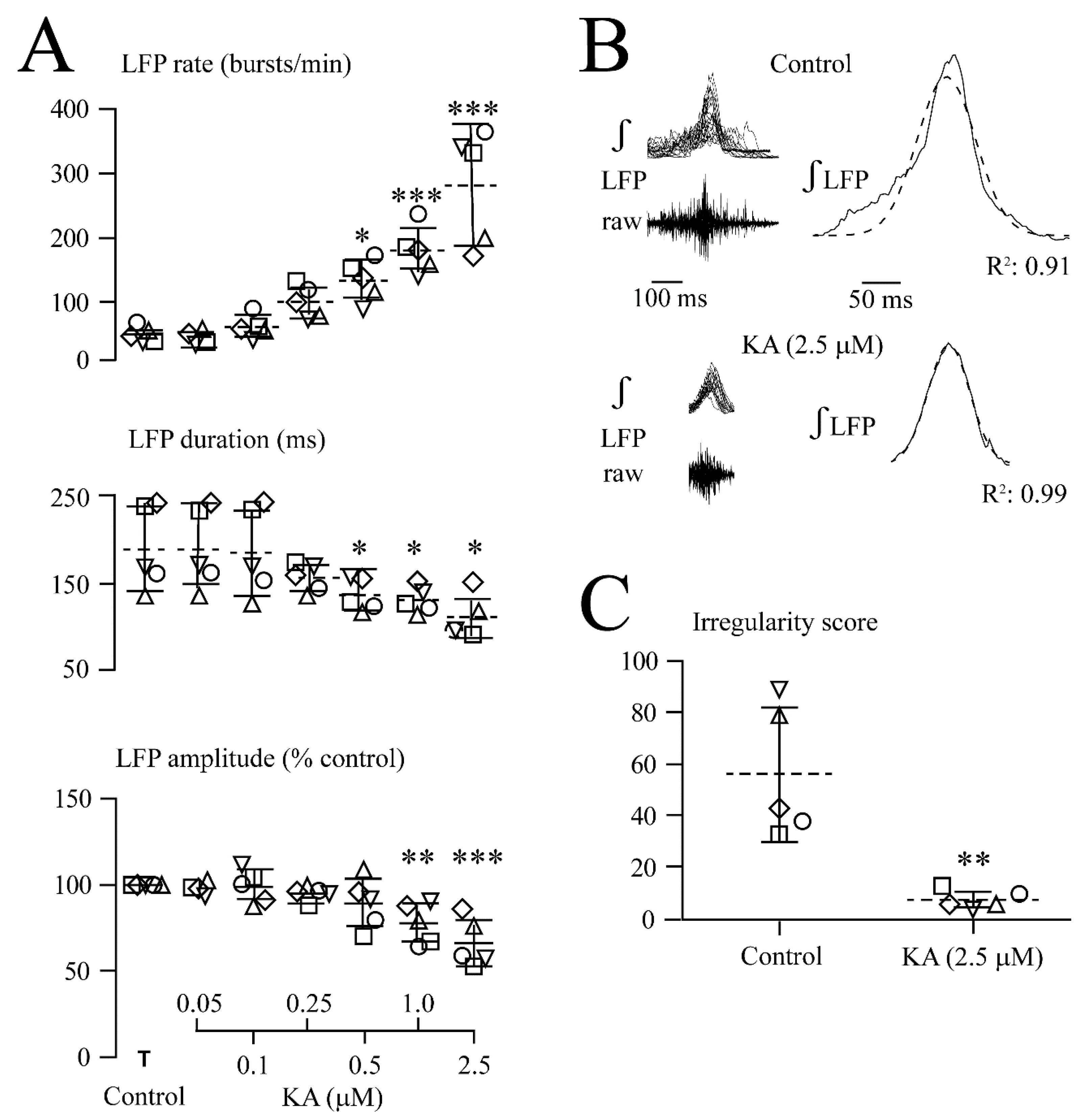
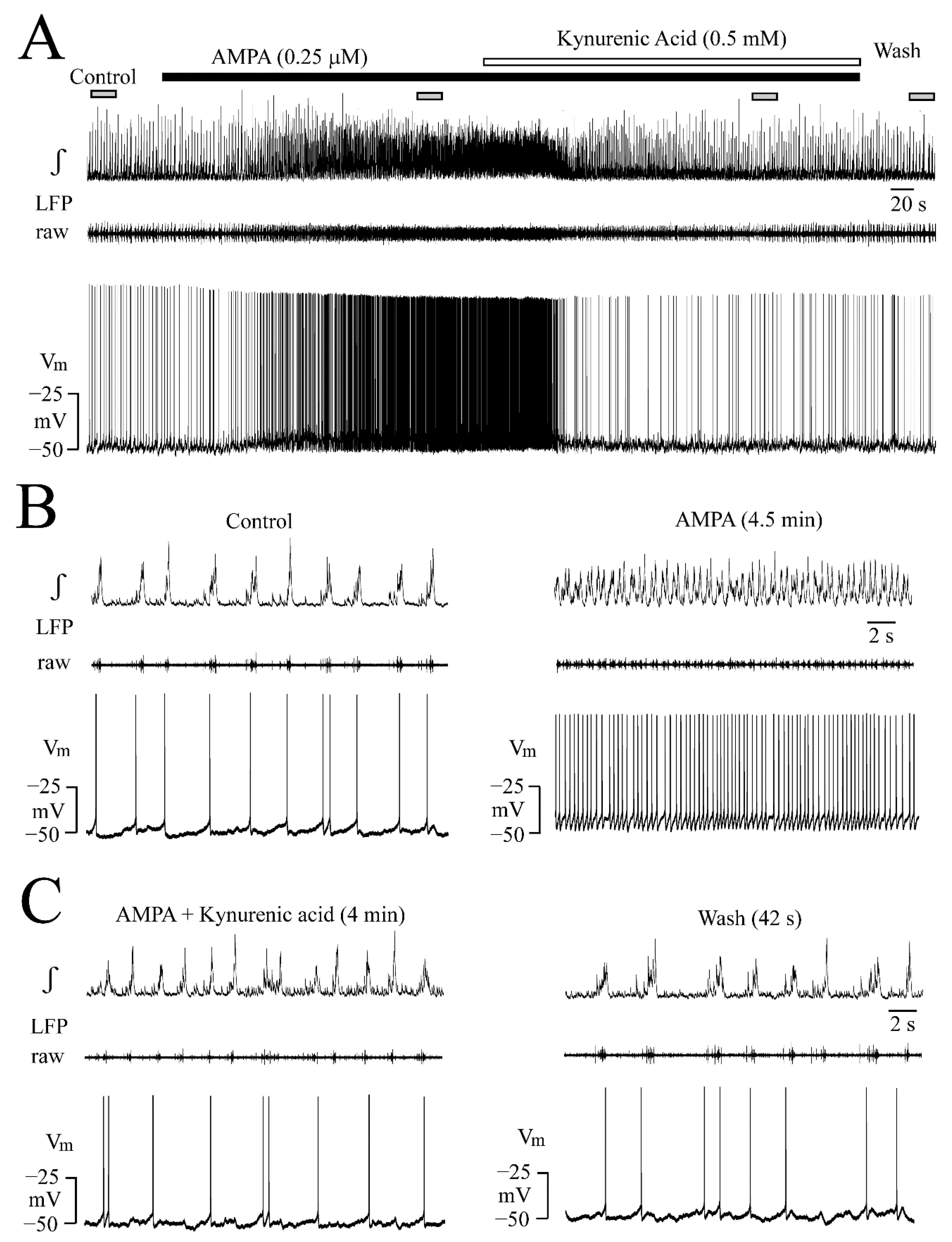
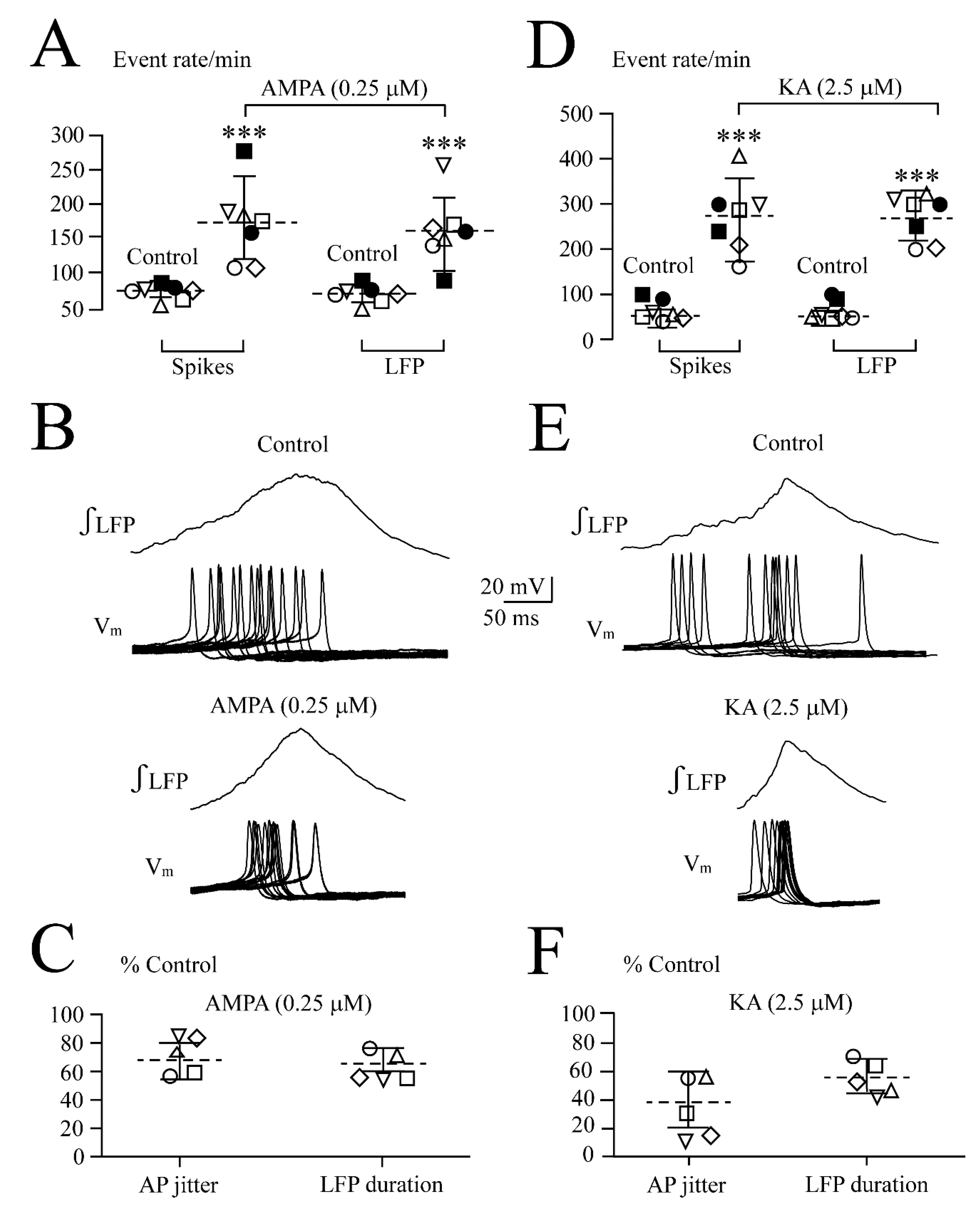
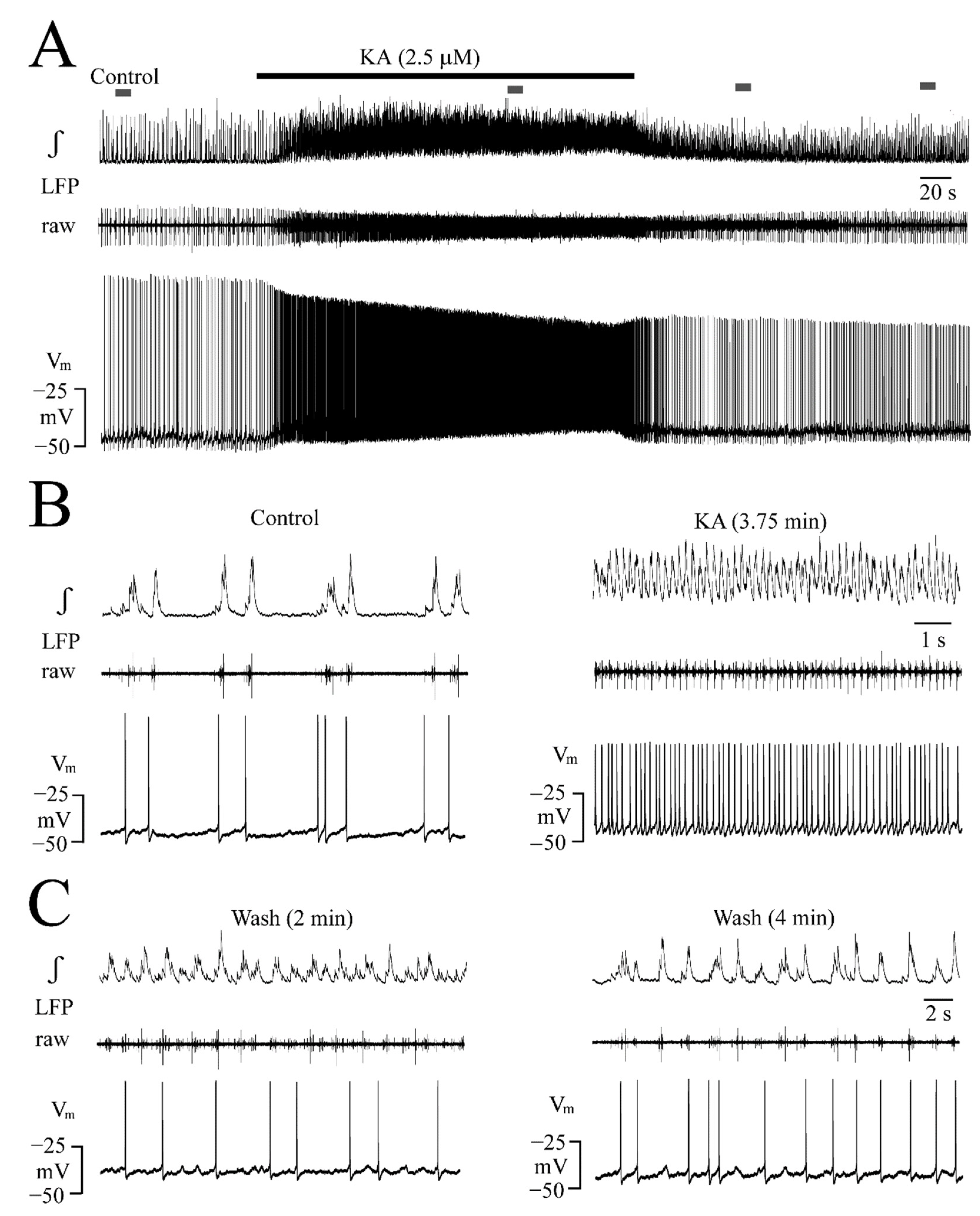
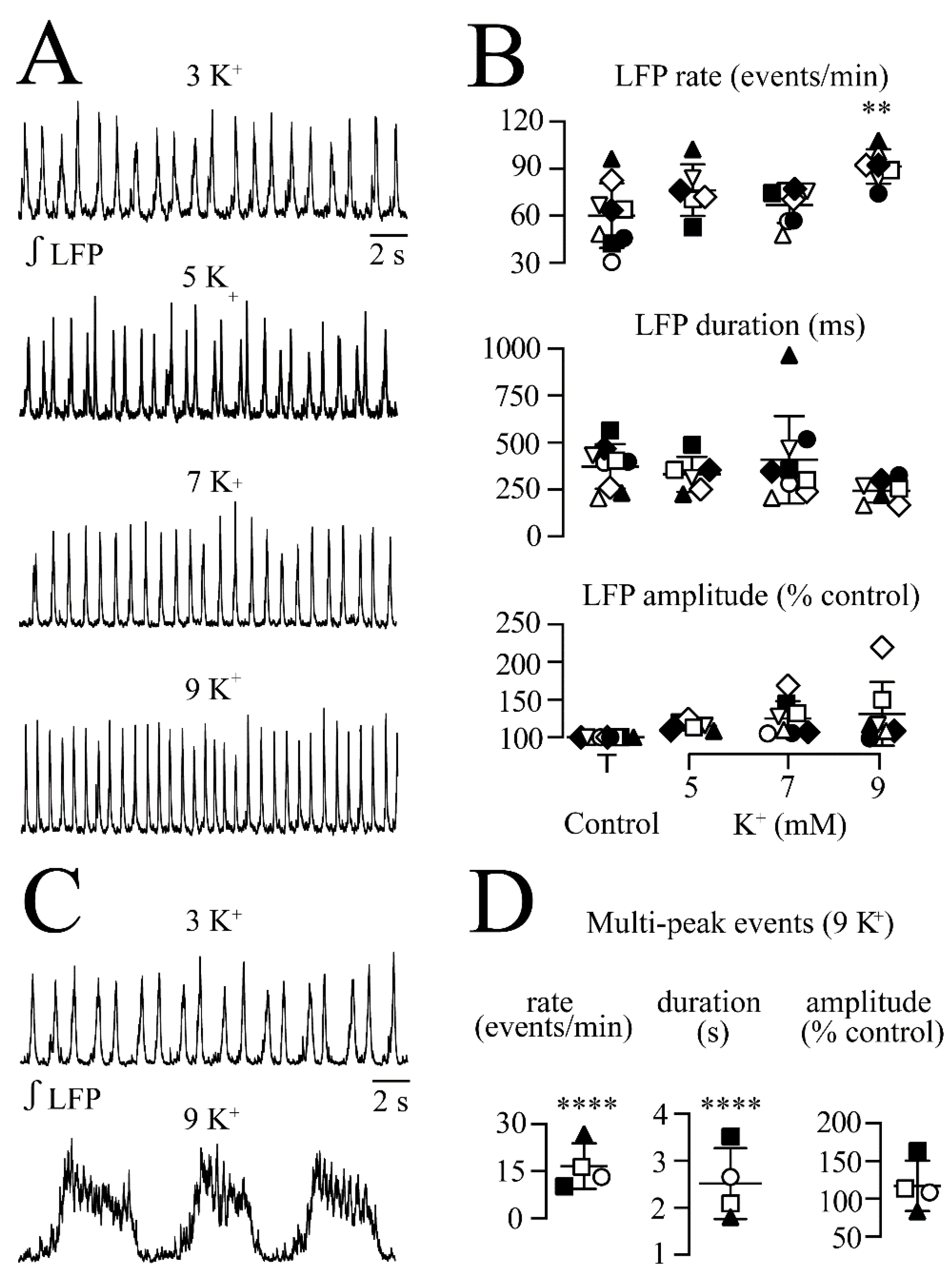
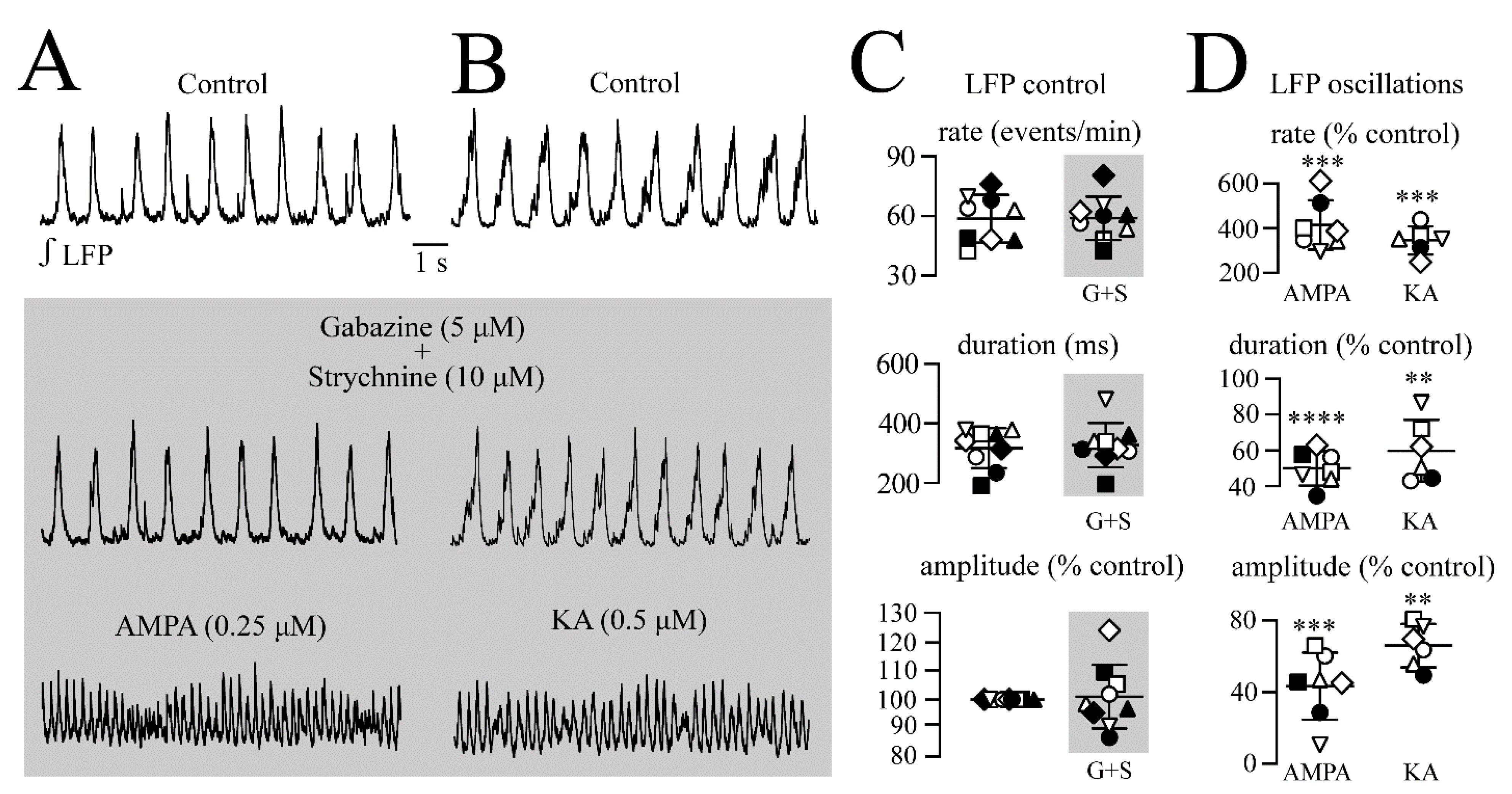
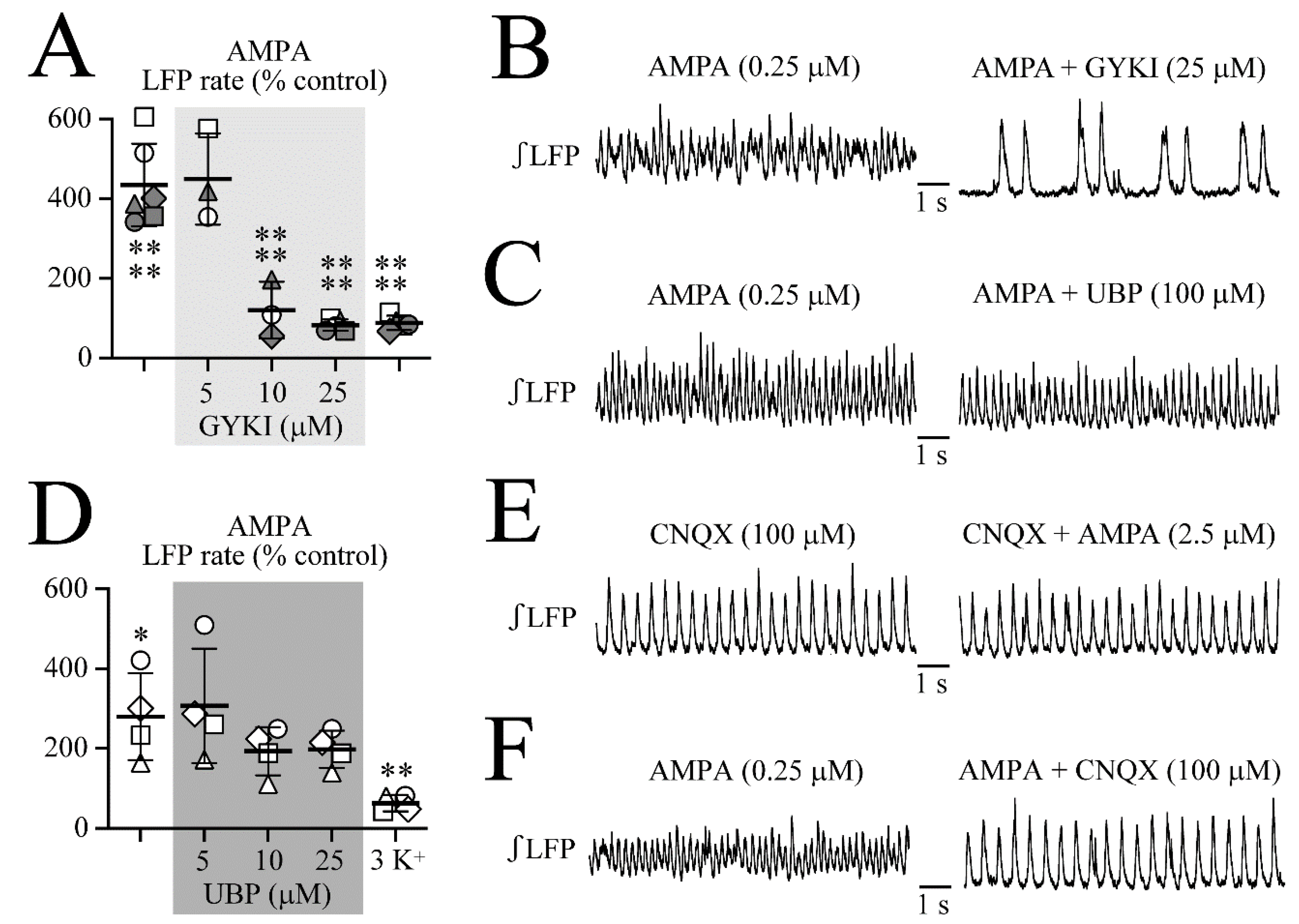
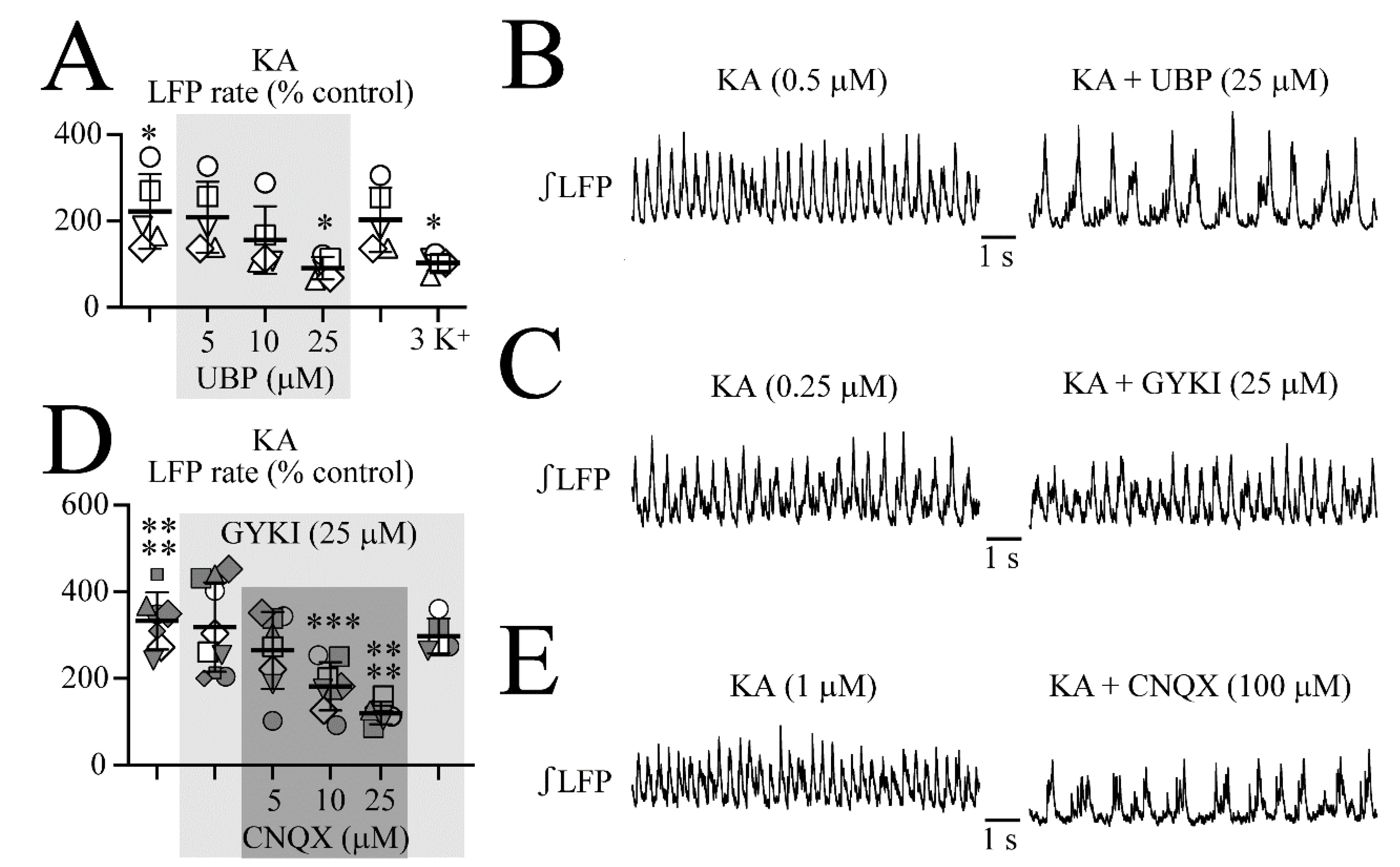
Publisher’s Note: MDPI stays neutral with regard to jurisdictional claims in published maps and institutional affiliations. |
© 2022 by the authors. Licensee MDPI, Basel, Switzerland. This article is an open access article distributed under the terms and conditions of the Creative Commons Attribution (CC BY) license (https://creativecommons.org/licenses/by/4.0/).
Share and Cite
Rawal, B.; Ballanyi, K. Mediation of Sinusoidal Network Oscillations in the Locus Coeruleus of Newborn Rat Slices by Pharmacologically Distinct AMPA and KA Receptors. Brain Sci. 2022, 12, 945. https://doi.org/10.3390/brainsci12070945
Rawal B, Ballanyi K. Mediation of Sinusoidal Network Oscillations in the Locus Coeruleus of Newborn Rat Slices by Pharmacologically Distinct AMPA and KA Receptors. Brain Sciences. 2022; 12(7):945. https://doi.org/10.3390/brainsci12070945
Chicago/Turabian StyleRawal, Bijal, and Klaus Ballanyi. 2022. "Mediation of Sinusoidal Network Oscillations in the Locus Coeruleus of Newborn Rat Slices by Pharmacologically Distinct AMPA and KA Receptors" Brain Sciences 12, no. 7: 945. https://doi.org/10.3390/brainsci12070945
APA StyleRawal, B., & Ballanyi, K. (2022). Mediation of Sinusoidal Network Oscillations in the Locus Coeruleus of Newborn Rat Slices by Pharmacologically Distinct AMPA and KA Receptors. Brain Sciences, 12(7), 945. https://doi.org/10.3390/brainsci12070945




